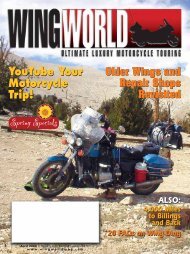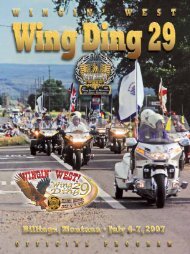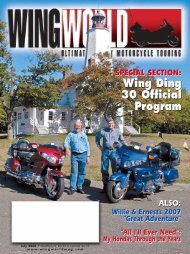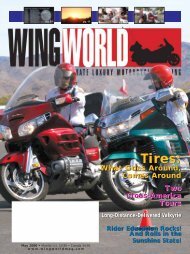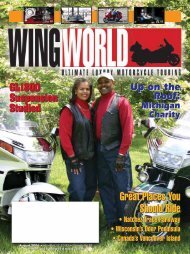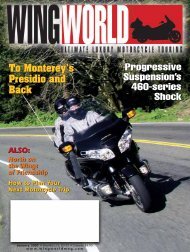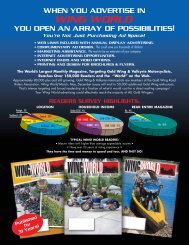to view pdf file of current issue - Wing World Magazine Archives
to view pdf file of current issue - Wing World Magazine Archives
to view pdf file of current issue - Wing World Magazine Archives
Create successful ePaper yourself
Turn your PDF publications into a flip-book with our unique Google optimized e-Paper software.
“In Case <strong>of</strong> Emergency” is a <strong>Wing</strong> <strong>World</strong>department we hope <strong>to</strong> include as <strong>of</strong>ten as possible in the magazine. It is our hope that the opinions andadvice shared in it will provide useful guidance <strong>to</strong> riders on ways <strong>to</strong> prevent and/or treat emergency situations that may arise on our roadways.In Case <strong>of</strong> Emergency:Traffic was light as I rode northout <strong>of</strong> Idyllwild, California, on acool, clear November day. It hads<strong>to</strong>rmed in the mountains the daybefore, and for the last half-hour or so Icould see that the higher peaks hadreceived a light dusting <strong>of</strong> snow. Bu<strong>to</strong>ther than the occasional pine cone anda few leaves, the roads had been cleanand dry as I climbed in<strong>to</strong> the higher elevations.Just minutes earlier, as I leftIdyllwild, I started seeing small patches<strong>of</strong> snow along the roadside. The roaditself, however, appeared dry.But even though the road appeareddry, an uneasy feeling slowed me <strong>to</strong> perhapsten or fifteen miles per hour as Ientered a moderate left-handed horseshoecurve. Suddenly, perhaps halfwaythrough the curve, the bike jerked violentlyand then stabilized. Black Ice! Careful not <strong>to</strong> rollon or <strong>of</strong>f the throttle, I warned myself. But withno further warning, the bike and I were quicklyfalling <strong>to</strong> my left. I tucked in tight as the bikehit the ground and slid down the road; it came<strong>to</strong> rest seconds later, straddling the doubleyellowdivider. As I pulled myself up, a quickscan showed that neither the bike nor Iappeared <strong>to</strong> be leaking fluids. Adrenalin flowing,I was able <strong>to</strong> get the bike upright on theside-stand in one attempt.And there I s<strong>to</strong>od, slightly dazed, in themiddle <strong>of</strong> a blind and icy corner. I wasn’t sureif I’d been hurt, and I wondered what I shoulddo next.Weeks earlier, I had enrolled in an AccidentScene Management Advanced BystanderAssistance course in Indio, California. Followingthe class, I planned <strong>to</strong> ride <strong>to</strong> Irvine, viaIdyllwild, <strong>to</strong> visit my daughter and grandkids.Yet there I was, not much more than an hourin<strong>to</strong> my ride and standing in the middle <strong>of</strong> theroad, with no cell phone coverage.Thankfully, I heard a vehicle approachingfrom the north. It turned out <strong>to</strong> be a SanJacin<strong>to</strong> State Park Ranger. He turned his truckaround, turned on his emergency lights, andmade sure I wasn’t seriously injured. Then hehelped move the bike <strong>to</strong> the side <strong>of</strong> the road.Over the course <strong>of</strong> the next hour or so, weobserved several vehicles get squirrelly comingaround that corner; one car almost went sideways.By John Davis • GWRRA #270167 • Peoria,Even though my left hand was hurting andmy helmet was scraped (indicating I had takena blow <strong>to</strong> the head), I didn’t feel I needed <strong>to</strong> bechecked out by EMS. After a bit <strong>of</strong> discussionwith the ranger, however, I was convinced Ishould have EMS look me over.When they didn’tfind anything obviously wrong with me, andwith nothing hurting but my left hand, Ideclined transportation for a more in-depthexam.And, upon closer inspection <strong>of</strong> the bike,it appeared safe <strong>to</strong> ride; the engine started andsounded good. So I thanked everyone andcompleted the trip <strong>to</strong> Irvine.At the following monthly AZ-R Chaptermeeting in Phoenix, I was asked <strong>to</strong> give a brieftalk about the hazards <strong>of</strong> hitting black ice on amo<strong>to</strong>rcycle. It was a bit embarrassing—mywife and I had just been presented ourGWRRA Master’s patches—but I spoke <strong>of</strong> myfirst-ever street bike crash. Now I’d like <strong>to</strong>share some <strong>of</strong> those analyses and conclusionswith you.Analysis – The RiderI believe I was physically and mentally preparedfor the ride. I also believe that I wascapable <strong>of</strong> executing the ride safely. I’ve riddena lot <strong>of</strong> miles, over a lot <strong>of</strong> years, on many differentbikes and in a variety <strong>of</strong> weather androad conditions. I <strong>of</strong>ten take one or more safetycourses a year and read many mo<strong>to</strong>rcyclesafety articles.Conclusion: Other than the fact that I wasArizonaA Black Ice Crash Self-AnalysisRed starburst indicates where my bike came <strong>to</strong> rest; beginning<strong>of</strong> red line is where I believe my bike first started falling.the one riding the bike at the time <strong>of</strong> thecrash, I don’t believe my trip preparationor riding capabilities were a contributingfac<strong>to</strong>r.Analysis – The BikePrior <strong>to</strong> leaving Phoenix, I had my ’06GL1800 ABS pr<strong>of</strong>essionally serviced andsafety checked. I was running DunlopElite 3’s with less than 4K miles, inflated<strong>to</strong> 42 PSI cold, front and rear. I <strong>of</strong>ten ridetwo-up, but I made no adjustments prior<strong>to</strong> this ride.Following the crash, I was a little concernedabout tire pressure, but the tireshop had <strong>to</strong>ld me 42 PSI is a reasonablepressure for long life and minimal cupping.Dunlop’s Website recommends 38PSI in front and 41 PSI in the rear tire.After some Web research, I get the impressionthis is a somewhat controversial subject;everyone has their opinion.Conclusion: I’m comfortable with the preparationand condition <strong>of</strong> the bike. I don’t considerit <strong>to</strong> be a contributing fac<strong>to</strong>r.Analysis – My Riding GearMy riding gear for this trip was a Nolanmodular helmet, GWRRA 3-in-1 jacket over aT-shirt, Lee Parks Design deerskin ridinggloves, Levis®, and Cruiserworks® ridingboots. In addition, I was wearing a pair <strong>of</strong> WileyX® sunglasses with polarized, Crizal® coatedprescription lenses.I believe my selection was pretty good.Thehelmet did its job, as did my gloves and jacket.Amazingly, I didn’t have so much as a red spo<strong>to</strong>n my skin! I’m not quite sure how thatworked out, but I’m grateful it did. Neither myboots nor my jeans showed any indication <strong>of</strong>contacting the road.My biggest concern about my riding gearthat day is with the sunglasses. I sent inquiriesasking for information or research on both thepolarized lenses and the coating, as I’m interestedin learning about their effect on the ability<strong>to</strong> see, or not see, black ice. I haven’t yetreceived a response, but I did find an onlinearticle indicating that, in some circumstances,polarized lenses may not provide the contrastthe eye needs <strong>to</strong> distinguish ice patches. But Ihaven’t been able <strong>to</strong> find anything that defini-March 2009 43



